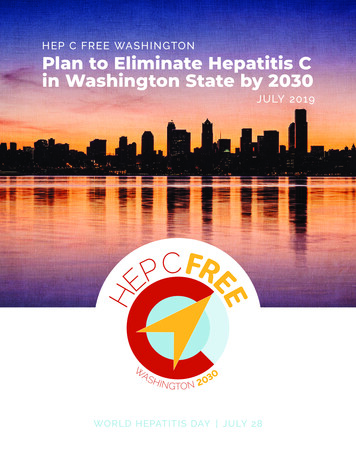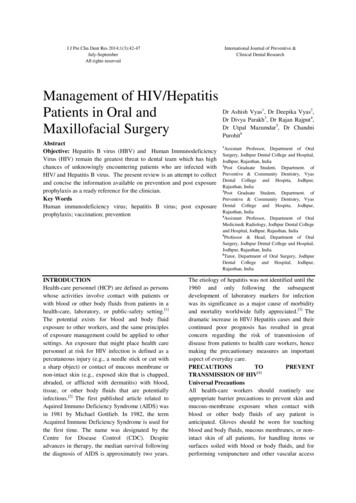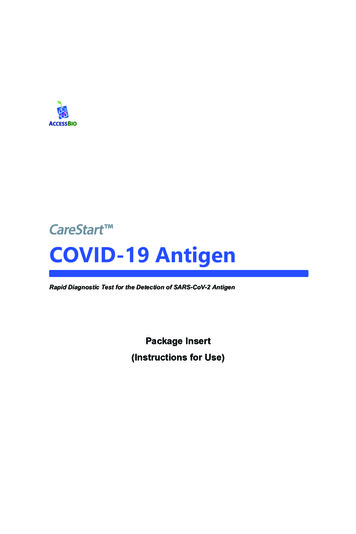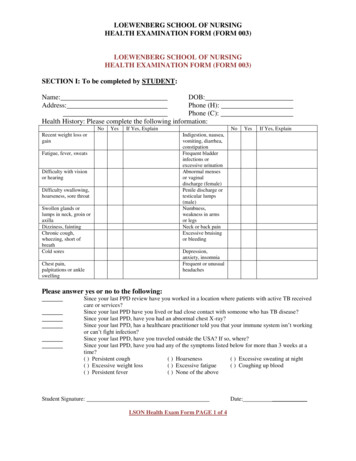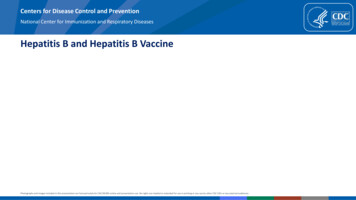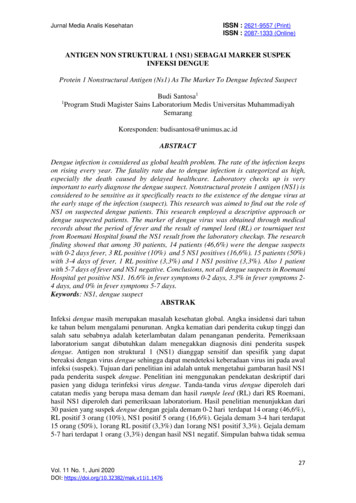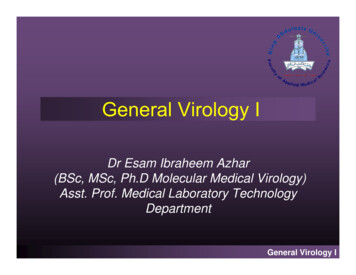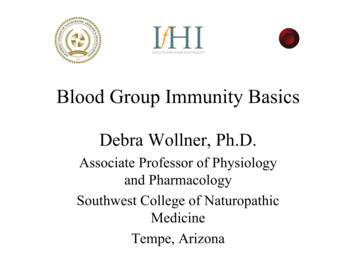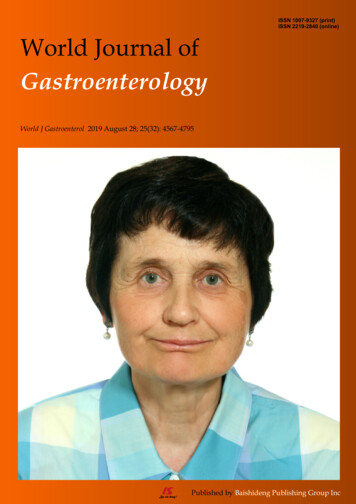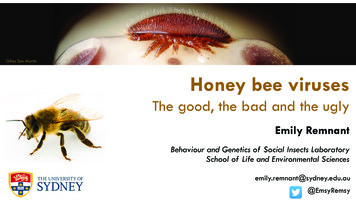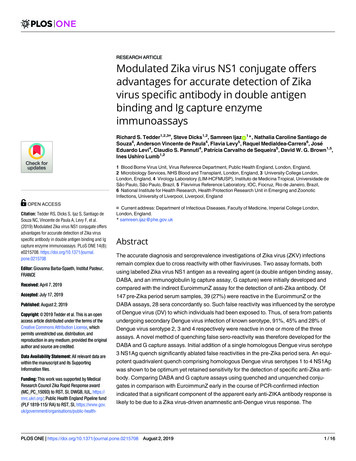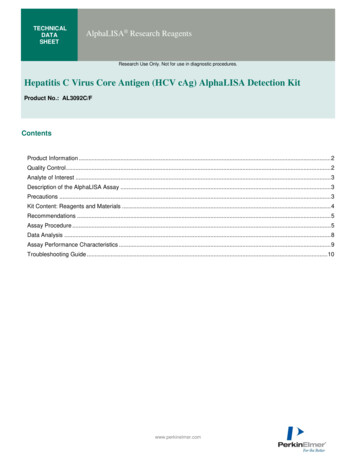
Transcription
TECHNICALDATASHEETAlphaLISA Research ReagentsResearch Use Only. Not for use in diagnostic procedures.Hepatitis C Virus Core Antigen (HCV cAg) AlphaLISA Detection KitProduct No.: AL3092C/FContentsProduct Information . 2Quality Control . 2Analyte of Interest . 3Description of the AlphaLISA Assay . 3Precautions . 3Kit Content: Reagents and Materials . 4Recommendations . 5Assay Procedure . 5Data Analysis . 8Assay Performance Characteristics . 9Troubleshooting Guide . 10www.perkinelmer.com
2Product InformationApplication:This kit is designed for the quantitative determination of HCV cAg in cell culture media using ahomogeneous AlphaLISA assay (no wash steps).Sensitivity:Lower Detection Limit (LDL): 374 pg/mLLower Limit of Quantification (LLOQ): 1190 pg/mLEC50: 259 ng/mLDynamic range:374 – 1 000 000 pg/mLFigure 1. Typical sensitivity curve in AlphaLISA Immunoassay Buffer. The data was generated using a whiteOptiplateTM-384 microplate and the EnVision Multilabel Plate Reader 2102 with Alpha option.Storage:Store kit, except analyte, in the dark at 4 C. Store the analyte and diluted analyte aliquots at -20 C. Avoid freeze-thaw cycles.Stability:This kit is stable for at least 12 months from the manufacturing date when stored in its originalpackaging and the recommended storage conditions. Undiluted analyte stored at -20 C is stablefor at least 3 months from the date of manufacturing.Quality ControlLot to lot consistency is confirmed in an AlphaLISA assay. Maximum and minimum signals, EC 50 and LDL were measuredon the EnVision Multilabel Plate Reader with Alpha option using the protocol described in this technical data sheet. Wecertify that these results meet our quality release criteria. Maximum counts may vary between bead lots and theinstrument used, with no impact on LDL measurement.TDS-ALXXX-Rev 01Page 2 of 11
3Analyte of InterestThe hepatitis C virus is one of many viruses that causes liver diseases (liver inflammation and liver fibrosis) and it istransmitted via blood such as unprotected sexual activity, blood transfusion, mother-to-infant transmission, oroccupational exposure to blood. About 143 (2%) million people worldwide have been infected with hepatitis C. ChronicHCV infection often leads to liver cirrhosis and failure. The infection can be detected by HCV serology and detection ofHCV antibodies. Quantitative detection of HCV cAg has been used increasingly as the most important marker formonitoring HCV titer, disease progression, and assessing antiviral treatment.Description of the AlphaLISA AssayAlphaLISA technology allows the detection of molecules of interest in buffer and cell culture media in a highly sensitive,quantitative, reproducible and user-friendly mode. In this AlphaLISA assay, a Biotinylated Anti-HCV cAg Antibody binds tothe Streptavidin-coated Alpha Donor beads, while another Anti-HCV cAg Antibody is conjugated to AlphaLISA Acceptorbeads. In the presence of the HCV cAg, the beads come into close proximity. The excitation of the Donor beads provokesthe release of singlet oxygen molecules that triggers a cascade of energy transfer in the Acceptor beads, resulting in asharp peak of light emission at 615 nm (Figure 2).Emission615 nmExcitation680 nmHCV cAgBiotinylatedAnti- HCV cAgStreptavidinDonor beadsAnti- HCV cAg AlphaLISAAcceptor beadsFigure 2. AlphaLISA HCV cAg Assay Principle.Precautions The Alpha Donor beads are light-sensitive. All the other assay reagents can be used under normal light conditions. AllAlpha assays using the Donor beads should be performed under subdued laboratory lighting ( 100 lux). Green filters(LEE 090 filters (preferred) or Roscolux filters #389 from Rosco) can be applied to light fixtures.Take precautionary measures to avoid contamination of the reagent solutions.The Biotinylated Anti-Analyte Antibody contains sodium azide. Contact with skin or inhalation should be avoided.TDS-ALXXX-Rev 01Page 3 of 11
4Kit Content: Reagents and MaterialsKit componentsAL3092HV(100 assay points***)AL3092C(500 assay points***)AL3092F(5000 assay points***)AlphaLISA Anti-HCV cAg Acceptorbeads stored in PBS, 0.05% Proclin300, pH 7.220 µL @ 5 mg/mL(1 brown tube, white cap)50 µL @ 5 mg/mL500 µL @ 5 mg/mL(1 brown tube, white cap) (1 brown tube, white cap)Streptavidin (SA)-coated Donor beadsstored in 25 mM HEPES, 100 mMNaCl, 0.05% Proclin-300, pH 7.440 µL @ 5 mg/mL(1 brown tube, black cap)100 µL @ 5 mg/mL1 mL @ 5 mg/mL(1 brown tube, black cap) (1 brown tube, black cap)Biotinylated Anti-HCV cAg Antibodystored in PBS, 0.1% Tween-20, 0.05%NaN3, pH 7.420 µL @ 500 nM(1 tube, black cap)50 µL @ 500 nM(1 tube, black cap)500 µL @ 500 nM(1 tube, black cap)HCV cAg Analyte stored in IAB20 µL @ 100 µg/mL(1 tube, clear cap)20 µL @ 100 µg/mL(1 tube, clear cap)20 µL @ 100 µg/mL(1 tube, clear cap)AlphaLISA Immunoassay Buffer(10X)2 mL, 1 small bottle10 mL, 1 medium bottle100 mL, 1 large bottle* Dilute analyte with 1X AlphaLISA Immunoassay Buffer (see page 7 for more details). The diluted analyte should beused within 60 minutes or aliquoted into screw-capped 0.5 mL polypropylene vials and stored at -20ºC for futureexperiments. The aliquoted analyte at -20 C is stable up to 84 days. Avoid freeze-thaw cycles. One vial contains anamount of analyte sufficient for performing 20 standard curves. Additional vials can be ordered separately(cat # AL3092S).**Extra buffer can be ordered separately (cat # AL000C: 10 mL, cat # AL000F: 100 mL).*** The number of assay points is based on an assay volume of 100 µL in 96-well plates or 50 µL in 96- or 384-wellassay plates using the kit components at the recommended concentrations.Sodium azide should not be added to the stock reagents. High concentrations of sodium azide ( 0.001 % final in theassay) might decrease the AlphaLISA signal. Note that sodium azide from the Biotinylated Antibody stock solution will notinterfere with the AlphaLISA signal (0.0001% final in the assay).Specific additional required reagents and materials:The following materials are recommended:TDS-ALXXX-Rev 01Page 4 of 11ItemSuggested sourceCatalog #TopSeal -A PlusAdhesive Sealing FilmPerkinElmer Inc.6050185EnVision -Alpha ReaderPerkinElmer Inc.-
5RecommendationsIMPORTANT: PLEASE READ THE RECOMMENDATIONS BELOW BEFORE USE The volume indicated on each tube is guaranteed for single pipetting. Multiple pipetting of the reagents may reducethe theoretical amount left in the tube. To minimize loss when pipetting beads, it is preferable not to pre-wet the tip. Centrifuge all tubes (including lyophilized analyte) before use to improve recovery of content (2000g, 10-15 sec).Re-suspend all reagents by vortexing before use. Use Milli-Q grade H2O (18 MΩ cm) to dilute 10X AlphaLISA Immunoassay Buffer and to reconstitute the lyophilizedanalyte. When diluting the standard or samples, change tips between each standard or sample dilution. When loadingreagents in the assay microplate, change tips between each standard or sample addition and after each set ofreagents. When reagents are added to the microplate, make sure the liquids are at the bottom of the well. Small volumes may be prone to evaporation. It is recommended to cover microplates with TopSeal-A AdhesiveSealing Films to reduce evaporation during incubation. Microplates can be read with the TopSeal-A Film in place. The AlphaLISA signal is detected with an EnVision Multilabel Plate Reader equipped with the Alpha option using theAlphaScreen standard settings (e.g. Total Measurement Time: 550 ms, Laser 680 nm Excitation Time: 180 ms,Mirror: D640as, Emission Filter: M570w, Center Wavelength 570 nm, Bandwidth 100 nm, Transmittance 75%). AlphaLISA signal will vary with temperature and incubation time. For consistent results, identical incubation times andtemperature should be used for each plate. The standard curves shown in this technical data sheet are provided for information only. A standard curve must begenerated for each experiment.Assay Procedure The protocol described below is an example for generating one standard curve in a 50 µL final assay volume (48wells, triplicate determinations). The protocols also include testing samples in 452 wells. If different amount ofsamples are tested, the volumes of all reagents have to be adjusted accordingly, as shown in the table below. Thesecalculations do not include excess reagent to account for losses during transfer of solutions or dead volumes. The standard dilution protocol is provided for information only. As needed, the number of replicates or the range ofconcentrations covered can be modified. Use of four background points in triplicate (12 wells) is recommended when LDL/LLOQ is calculated. Onebackground point in triplicate (3 wells) can be used when LDL/LLOQ is not calculated.TDS-ALXXX-Rev 01Page 5 of 11
6VolumeFormat# nylatedAntibodySADonorbeadsPlate recommendationAL3092HV100100µL10 µL20 µL20 µL50 µLWhite OptiPlate-96 (cat # 6005290)White ½ AreaPlate-96 (cat # 6005560)250100µL10 µL20 µL20 µL50 µLWhite OptiPlate-96 (cat # 6005290)White ½ AreaPlate-96 (cat # 6005560)50050 µL5 µL10 µL10 µL25 µLWhite ½ AreaPlate-96 (cat # 6005560)White OptiPlate-384 (cat # 6007290)Light gray AlphaPlate -384 (cat #6005350)1 25020 µL2 µL4 µL4 µL10 µLLight gray AlphaPlate-384 (cat # 6005350)ProxiPlate -384 Plus (cat # 6008280)White OptiPlate-384 (cat # 6007290)2 50010 µL1 µL2 µL2 µL5 µLLight gray AlphaPlate-1536 (cat #6004350)5 00050 µL5 µL10 µL10 µL25 µLWhite ½ AreaPlate-96 (cat # 6005560)White OptiPlate-384 (cat # 6007290)Light gray AlphaPlate-384 (cat # 6005350)12 50020 µL2 µL4 µL4 µL10 µLLight gray AlphaPlate-384 (cat # 6005350)ProxiPlate-384 Plus (cat # 6008280)White OptiPlate-384 (cat # 6007290)25 00010 µL1 µL2 µL2 µL5 µLLight gray AlphaPlate-1536 (cat #6004350)AL3092CAL3092FTDS-ALXXX-Rev 01Page 6 of 11
7Protocol for HCVcAg AlphaLISA Assay3 Step Protocol (3 incubation steps) – Dilution of standards can be done in 1X AlphaLISA Immunoassay Buffer.The protocol described below is for one standard curve (48 wells. If a different amount of samples are tested, the volumesof all reagents have to be adjusted accordingly.1)Preparation of 1X AlphaLISA Immunoassay Buffer:Add 1 mL of 10X AlphaLISA Immunoassay Buffer to 9 mL Milli-Q grade H2O.2)Preparation of HCVcAg analyte standard dilutions:a. Thaw 20 µL sample of HCVcAg.b. Add 180 µL of 1X AlphaLISA Immunoassay Buffer to 20 μL (2 μg) HCVcAg.c. Aliquot and store unused diluted analyte standard at -20 C.d. Prepare standard dilutions as follows in 1X AlphaLISA Immunoassay Buffer (change tip between eachstandard dilution):***TubeVol. ofHCVcAg (µL)Vol. ofdiluent (µL) *ABCDEFGHIJKLM ** (background)N ** (background)O ** (background)P ** (background)10 µL of diluted HCVcAg60 µL of tube A60 µL of tube B60 µL of tube C60 µL of tube D60 µL of tube E60 µL of tube F60 µL of tube G60 µL of tube H60 µL of tube I60 µL of tube J60 µL of tube 00[HCVcAg] in standard curve(g/mL in 5 -093.0E-101.0E-103.0E-111.0E-113.0E-120000(pg/mL in 5 µL)1 000 000300 000100 00030 00010 0003 0001 000300100301030000Dilute standards in diluent (e.g. 1X AlphaLISA Immunoassay Buffer).At low concentrations of analyte, a significant amount of analyte can bind to the vial. Therefore, load the analytestandard dilutions in the assay microplate within 60 minutes of preparation.Four background points in triplicate (12 wells) are used when LDL is calculated. If LDL does not need to becalculated, one background point in triplicate can be used (3 wells).3) Preparation of 5X AlphaLISA Anti-HCVcAg Antibody Acceptor beads (50 µg/mL):a. Prepare just before use.b. Add 50 µL of 5 mg/mL AlphaLISA Anti- HCVcAg Antibody Acceptor to 4950 µL of 1X AlphaLISAImmunoassay Buffer.4) Preparation of 5X Biotinylated Anti- HCVcAg Antibody (5 nM):a. Prepare just before use.b. Add 50 µL of 500 nM Biotinylated Anti- HCVcAg Antibody to 4950 µL of 1X AlphaLISA ImmunoassayBuffer.TDS-ALXXX-Rev 01Page 7 of 11
85) Preparation of 2X Streptavidin (SA) Donor beads (40 µg/mL):a. Prepare just before use.b. Keep the beads under subdued laboratory lighting.c. Add 100 µL of 5 mg/mL SA-Donor beads to 12 400 µL of 1X AlphaLISA Immunoassay Buffer.6) In a white Optiplate (384 wells):Add 5 µL of each analyte standard dilutionAdd 10 µL of 5X Anti-HCVcAg Acceptor beads (10 µg/mL final)Incubate 30 minutes at 23 CAdd 10 µL of 5X Biotinylated Anti-HCVcAg Antibody (1 nM final)Incubate 60 minutes at 23 CAdd 25 µL of 2X SA-Donor beads (20 µg/mL final)Incubate 30 minutes at 23 C in the darkRead using EnVision-Alpha Reader (615 nm)Data Analysis Calculate the average count value for the background wells.Generate a standard curve by plotting the AlphaLISA counts versus the concentration of analyte. A log scale can beused for either or both axes. No additional data transformation is required.Analyze data according to a nonlinear regression using the 4-parameter logistic equation (sigmoidal dose-responsecurve with variable slope) and a 1/Y2 data weighting (the values at maximal concentrations of analyte after the hookpoint should be removed for correct analysis).The LDL is calculated by interpolating the average background counts (12 wells without analyte) 3 x standarddeviation value (average background counts (3xSD)) on the standard curve.The LLOQ as measured here is calculated by interpolating the average background counts (12 wells without analyte) 10 x standard deviation value (average background counts (10xSD)) on the standard curve. Alternatively, the trueLLOQ can be determined by spiking known concentrations of analyte in the matrix and measuring the percentrecovery, and then determining the minimal amount of spiked analyte that can be quantified within a given limit(usually /- 20% or 30% of the real concentration).Read from the standard curve the concentration of analyte contained in the samples.If samples have been diluted, the concentration read from the standard curve must be multiplied by the dilution factor.TDS-ALXXX-Rev 01Page 8 of 11
9Assay Performance CharacteristicsAlphaLISA assay performance described below was determined using the 3 step protocol using AlphaLISA ImmunoassayBuffer (IAB) as assay buffer. The analytes (standards) were prepared in IAB, DMEM 10% FBS, or RPMI 10% FBS,and all other components were prepared in IAB. Assay Sensitivity:The LDL was calculated as described above. The values correspond to the lowest concentration of analyte that can bedetected in a volume of 5 µL sample using the recommended assay conditions.LDL (pg/mL)*(Analyte diluent)# of experiments3741042IABDMEM 10% FBS9611946RPMI 10% FBS1* Note that LDL can be decreased (i.e. sensitivity increased) by increasing the volume of analyte in the assay (e.g. use10 µL of analyte in a final assay volume of 50 µL). Use of RPMI with 10%FBS should be avoided. Assay Precision:The following assay precision data were calculated from the three independent assays using two different kit lots. In eachlot, the analytes were prepared in IAB and DMEM 10% FBS. All other components were prepared in IAB. Each assayconsisted of one standard curve comprising 12 data points (each in triplicate) and 12 background wells (no analytes). Theassays were performed in 384-well format. Intra-assay precision:The intra-assay precision was determined using a total of 16 independent determinations in triplicate. Shown as CV%. HCV cAgIABDMEM 10% FBSCV (%)78Inter-assay precision:The inter-assay precision was determined using a total of 3 independent determinations with 9 measurements for 3ng/mL sample. Shown as CV%.TDS-ALXXX-Rev 01Page 9 of 11HCV cAgIABDMEM 10% FBSCV (%)715
10 Spike Recovery:Three known concentrations of analyte were spiked into IAB and DMEM 10% FBS. All samples, including non-spikeddiluents were measured in the assay. Note that the analytes for the respective standard curves were prepared in IAB andDMEM 10% FBS. All other assay components were diluted in IAB.SpikedTDS-ALXXX-Rev 01Page 10 of 11% RecoveryHCV cAg (ng/mL)IABDMEM 10% FBS30959410879538696
11Troubleshooting GuideYou will find detailed recommendations for common situations you might encounter with your AlphaLISA Assay kit mlFOR RESEARCH USE ONLY. NOT FOR USE IN DIAGNOSTIC PROCEDURES.This product is not for resale or distribution except by authorized distributors.LIMITED WARRANTY: PerkinElmer warrants that, at the time of shipment, the above named product is free from defects in material and workmanship and conforms to the specifications setforth above. PerkinElmer makes no other warranty, express or implied with respect to the product and expressly disclaims any warranty of merchantability or fitness for any particularpurpose. Notification of any breach of the foregoing warranty must be made within 60 days of receipt of the product, unless otherwise provided in writing by PerkinElmer. No claim shallbe honored if the customer fails to notify PerkinElmer within the period specified. The sole and exclusive remedy of the customer for any breach of the forego ing warranty is limited toeither the replacement of the non-conforming product or the refund of the invoice price of the product. PERKINELMER SHALL NOT BE LIABLE FOR ANY DIRECT, INDIRECT, SPECIAL,INCIDENTAL, CONSEQUENTIAL OR PUNITIVE DAMAGES, WHETHER BASED ON CONTRACT, TORT, STRICT LIABILITY OR OTHERWISE, ARISING OUT OF THE DESIGN, MANUFACTURE,SALE, DELIVERY, OR USE OF THE PRODUCTS, EVEN IF THE LIMITED REMEDIES PROVIDED HEREIN FAIL OF THEIR ESSENTIAL PURPOSE OR PERKINELMER IS ADVISED OF THEPOSSIBILITY OF SUCH DAMAGES.PerkinElmer, Inc.940 Winter StreetWaltham, MA 02451 USAP: (800) 762-4000 or( 1) 203-925-4602www.perkinelmer.comFor a complete listing of our global offices, visit www.perkinelmer.com/ContactUsCopyright 2012, PerkinElmer, Inc. All rights reserved. PerkinElmer is a registered trademark of PerkinElmer, Inc. All other trademarks are the property of their respective owners.TDS-ALXXX-Rev 01Page 11 of 11
beads. In the presence of the HCV cAg, the beads come into close proximity. The excitation of the Donor beads provokes the release of singlet oxygen molecules that triggers a cascade of energy transfer in the Acceptor beads, resulting in a sharp peak of light emission at 615 nm (Figure 2). Figure 2. AlphaLISA HCV cAg Assay Principle. Precautions
